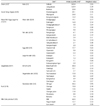Abstract
Objectives
Maintaining a balanced diet is very crucial for adolescents. However, adolescents, who may have a short notion about the amount of food, find it difficult to plan daily meals by applying the target pattern proposed by the Korean Nutrition Society. This study was carried out to revise the target pattern based on cooked dishes instead of raw material food groups as an easier way for Korean adolescents to plan their meals.
Methods
Target pattern for Korean adolescents were revised based on the following: 1st, categorize dish groups, 2nd, calculate representative values of each dish based on the adolescent' intake amount. 3rd, assign the recommended number of intake for each dish. Validity of the target pattern for Korean adolescent meal plan was examined by the energy content, energy contribution ratio, and NAR & INQ of nutrients.
Results
The 11 dish groups categorized were bab; gook·tang·gigae; side dishes of meat, fish, egg, legume, kimchi, vegetable, seaweed; and between meal of fruit, and milk·dairy product. Based on the representative energy values, recommended number of intake were assigned to each dish. For boys, bab and gook·tang·gigae: 3 each; meat, fish, egg, and legume: 1 each; kimchi and vegetable: 3 each; seaweed: 1; fruit and milk·dairy product: 2 each were assigned. For girls, bab and gook·tang·gigae: 2 each; meat, fish, egg, and legume: choice of 3 dishes, 1 each; kimchi and vegetable: 3 each; seaweed: 1; fruit and milk·dairy product: 2 each were assigned. Energy contents, energy contribution ratio of carbohydrate, protein, and fat for boys and girls were in adequate range. The NARs were 1.0 and INQs were ≥ 1.0 for all nutrients examined.
Figures and Tables
Table 4
Representative nutritional value of each dish in target pattern for Korean adolescent meal plan

Table 5
Comparison of caloric contents of meat·fish·egg·legumes dish in target pattern and target pattern for Korean adolescent meal plan

Table 6
Serving assignment of food and dish groups in target pattern and target pattern for Korean meal plan

References
1. Bae JK. Usage-based pricing model for food waste, participation of residents is the key point. 2013. cited June 4, 2013. Abailable from http://www.munhwa.com/news/view.html?no=2013060401073137191006.
2. Choi J, Moon HK. Comparison of dietary patterns by sex and urbanization in different economic status. Korean J Community Nutr. 2008; 13(3):346–358.
3. Goo JO, Lim HS, Jung YJ, Yoon JS, Lee AR, Lee JH. Understanding basic nutrition. 1st revision. Seoul: Powerbook;2012. p. 27–30.
4. Hong JH, Kim SY. Correlation between eating behavior and stress level in high school students. J Korean Soc Food Sci Nutr. 2014; 43(3):459–470.
5. Hur IY, Moon HK. A Study on the Menu Patterns of Residents in Kangbukgu( I ) -Whole Menu Patterns and Menu Patterns by Meal. Korean J Community Nutr. 2001; 6(4):686–702.
6. Kim AR, Kim MJ, Kim Y. Nutritional Assessment of Menu Plan Prepared according to the Target Pattern: Menu Prepared by Home Economics Teachers and Middle-School Girls. Korean J Community Nutr. 2011; 16(3):375–385.
7. Kim JO, Kim Y. Assessment of menu plan prepared by middle school students according to ordinary meal pattern and single serving size. Korean J Community Nutr. 2013; 18(4):333–343.
8. National Research Council.
Y Kim
. Recommended Dietary Allowances. 10th ed. Seoul: Suhaksa;1989. p. 87. USA original.
9. Korea Health Industry Development Institute. In-depth analysis on the dietary intake survey of infant, children and adolescents (II). 2010. cited March 15, 2012. Available from http://rnd.mfds.go.kr/documentReport/documentReportResult.do.
10. Lee HY, Kim Y. Revision and Application of the Target Pattern in Food Guidance System: Administered to 2nd grade middle school students. Korean J Community Nutr. 2014; 19(3):274–282.
11. Lee JH, Kim MR, Min HS, Lee YE, Song ES, Kwon SJ, Kim MJ, Song HN. Food and experimental cookery by scientific explanation. Seoul: Kyomunsa;2008. p. 190–196.
12. Statics Korea. 2013 Korea Social Index, 0n-line Periodical. 2014. cited January 7,2015. Available from http://kostat.go.kr/wnsearch/search.jsp.
13. The Korean Nutrition Society. Food values of portions commonly used. Seoul: 1998. p. 31–492.
14. The Korean Nutrition Society. Dietary reference intakes for Koreans. 1st revision. Seoul: 2010. p. 524–544.




 PDF
PDF ePub
ePub Citation
Citation Print
Print







 XML Download
XML Download